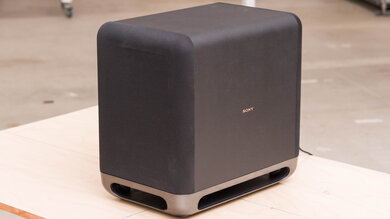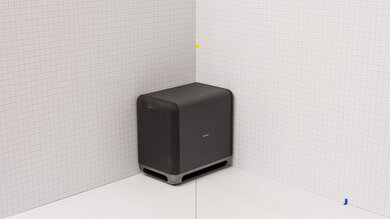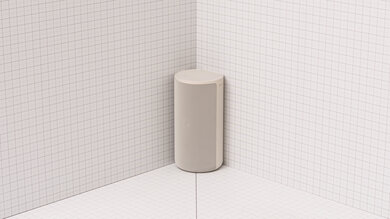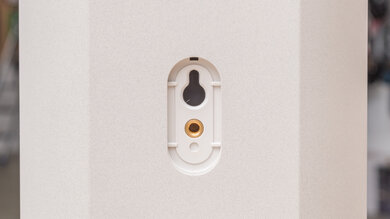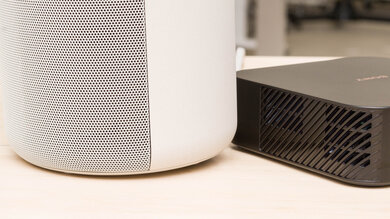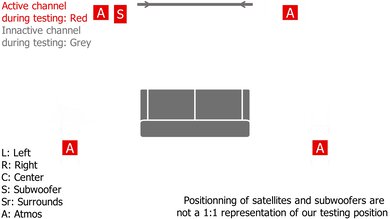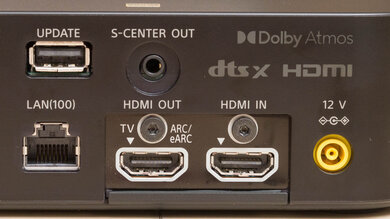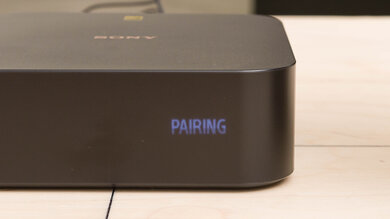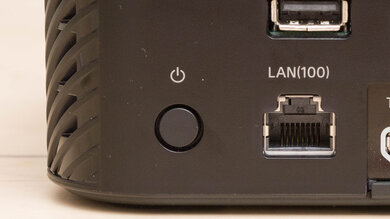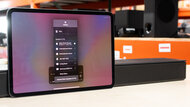The Sony HT-A9 with Bass Module is a 4.1.4 setup with a very unique design. The manufacturer's 360 Spatial Sound Mapping technology offers a fantastic soundstage performance, so your audio seems to fill the room around you. The addition of the SA-SW5 subwoofer helps reproduce a more extended low-bass, too. With its Sound Field Optimization feature turned on, its sound profile is a bit muddy, so vocals and lead instruments are a bit thin. That said, its Atmos performance is among the best of the soundbars we've tested.
Note: The standalone Sony HT-A9 is compatible with both the SA-SW5 and the SA-SW3 subwoofers. Our results are only valid for the SA-SW5 subwoofer.
Our Verdict
The Sony HT-A9 with Bass Module is satisfactory for mixed usage. This 4.1.4 setup has a Sound Field Optimization room correction feature that optimizes audio reproduction based on your room's acoustics. With this feature on, its sound profile is a bit muddy, so vocals and lead instruments are thin. That said, its incredible soundstage performance can immerse you in your audio content. It supports Atmos content, too, and its surrounds performance is very good.
-
Fantastic soundstage.
-
Immersive Atmos experience.
-
Doesn't get loud.
-
No graphic EQ.
The Sony HT-A9 with Bass Module is good for dialogue-centric content like TV shows. Voices are reproduced pretty clearly, though they may sound a bit thin due to the muddiness in the high-bass. There's a dialogue enhancement feature to make voices more clear, though. This setup lacks a discrete center channel, meaning you may notice some holes in the soundstage. That said, Acoustic Center Sync lets you pair it with a compatible BRAVIA TV to use your TV speakers as its discrete center. While this helps anchor voices to a more accurate location in the soundstage, we also noticed that it can reduce sound quality.
-
EQ presets.
-
Dialogue enhancement feature.
-
Lacks discrete center channel.
The Sony HT-A9 with Bass Module is satisfactory for music. Its Sound Field Optimization feature automatically adjusts audio reproduction based on your room's acoustics. On its 'Standard Surround' mode, its sound profile is a bit muddy, so vocals and lead instruments can be thin. There are some EQ presets and a subwoofer volume feature to help you adjust its sound, though.
-
EQ presets.
-
Fantastic soundstage.
-
Doesn't get loud.
-
No graphic EQ.
The Sony HT-A9 with Bass Module is satisfactory for movies. Its 360 Spatial Sound Mapping technology offers an incredibly wide and immersive-sounding soundstage. Its discrete surround speakers accurately localize sound objects in the soundstage, and it also supports Dolby Atmos content. You can even use its Immersive AE feature to turn on its up-firing speakers for a more immersive sound. That said, it seems to be missing a touch of low bass, so you may not feel as much rumble in action-packed scenes.
-
Fantastic soundstage.
-
Immersive Atmos experience.
-
Doesn't get loud.
-
Lacks a bit of low-bass.
- 7.4 Mixed Usage
- 7.5 Dialogue/TV Shows
- 7.4 Music
- 7.4 Movies
Changelog
- Updated Sep 14, 2023: Updated text in Other Input Specifications box for clarity. No changes in test results.
- Updated Sep 11, 2023: Added information about updating the bar to firmware version 1.779 for ALLM and HDMI Forum support in the Video Passthrough to TV box. No changes in the score.
- Updated Apr 06, 2023: Added cable lengths to In The Box.
- Updated Apr 05, 2023: Converted to Test Bench 1.1. With this update, we've added a Mounting test and added information aboutSubwoofer Output, Spotify Connect, and Microphone Mute.
- Updated Nov 10, 2021: Review published.
Check Price
Differences Between Sizes And Variants
The Sony HT-A9 with Bass Module is available in 'Light Grey' with a black subwoofer. You can see the label for the model we tested here.
You can also find this setup with Sony's SA-SW3 subwoofer. However, we haven't tested the setup in this configuration, so we can't confirm its performance.
If you come across another version of the Sony HT-A9 with Bass Module, let us know in the discussions, and we'll update our review.
Compared To Other Soundbars
The Sony HT-A9 with Bass Module has a very unique design. Instead of a large bar, this setup has four speakers and a small control box, which may be more suitable for some users' setups. Thanks to the manufacturer's 360 Spatial Sound technology, it offers a very wide and immersive soundstage performance that stands out among the other soundbars we've tested. Its Atmos performance is very immersive; however, it lacks a touch of low-bass compared to other premium setups like the Bose Smart Soundbar 900.
See also our recommendations for the best soundbars, the best Dolby Atmos soundbars, and the best soundbars with subwoofer.
The Sony BRAVIA Theater Quad with Bass Module is the successor to the Sony HT-A9 with Bass Module. The most immediate difference is in the design of the discrete speakers. The previous generation's were cylindrical and bulky, while the newer model opts for a sleek, rectangular design with dual-function mounts/stands. The Bass Module (subwoofer) remains the same. While there are similarities in performance and features, there are some trade-offs, too. The Theater Quad has a better default frequency response and a better stereo dynamics performance, which is a great fit for movies. That said, pushing the volume too high can result in the speaker's malfunctioning. While both systems feature HDMI 2.1 compatibility, with 4k passthrough @ 120Hz, the Theater Quad's latency performance isn't the best and might require some tweaking of the AV Sync feature. For this reason, the HT-A9 has the edge if you plan on using your setup for gaming.
The Sony HT-A9 with Bass Module and the Sony HT-A7000 with Speakers + Bass Module are both premium setups. The HT-A9 has a unique design that may be more suitable for users with less space in their setup. It also has better soundstage and Atmos performances. That said, the HT-A7000 has a better center channel performance, and it can reproduce a more extended low-bass with the same subwoofer.
The Sonos Arc and the Sony HT-A9 with Bass Module are two premium soundbar setups. The Sonos is a standalone 5.0.2 bar with a discrete center channel. It can get louder, and you can also upgrade it with a sub and satellites. The better-built Sony has better soundstage, surround, and Atmos performances. It even comes with a Full HDMI In port for high-quality passthrough and supports more wireless playback options.
The Samsung HW-Q990B and the Sony HT-A9 with Bass Module are two very different setups. They're both very versatile Dolby Atmos soundbars, and the Sony soundbar's unique speaker design means that you can place them anywhere in your setup, resulting in a better soundstage. That said, the Samsung soundbar reproduces more low-bass. It gets louder, and there's less compression at max volume, too. With its discrete center channel, the Samsung soundbar's vocal reproduction is better, too. Both bars will please most listeners, but your personal preferences will decide which is best for you.
The Bose Smart Soundbar 900 with Speakers + Bass Module is better than the Sony HT-A9 with Bass Module. The Bose is a 5.1.2 setup with better center and surround performances. It can reproduce a more extended low-bass, and it gets louder with less compression at max volume. That said, the Sony has better Atmos and soundstage performances. Unlike the Bose, it also supports DTS content.
The JBL Bar 9.1 is better than the Sony HT-A9 with Bass Module. The JBL is a 5.1.4 setup with a discrete center channel. It gets louder than the Sony, and there's less compression when pushed to max volume. It can also reproduce a more extended low bass. That said, the better-built Sony offers better soundstage and Atmos performances.
The Sonos Arc with Sub + One SL Speakers and the Sony HT-A9 with Bass Module are both very premium setups. The Sonos is a 5.1.2 setup with better center and surround performances, and it can also get louder with less compression at max volume. There's even an optical port available, which the Sony lacks. That said, the 4.1.4 Sony has a very unique design and better soundstage and Atmos performances. There's even a Full HDMI In port for high-quality passthrough, unlike the Sonos.
The Samsung HW-Q950A is better than the Sony HT-A9 with Bass Module. The Samsung is an 11.1.4 setup that can reproduce a more extended low-bass. It has better center and surround performances, and it can also get louder. There are even more sound enhancement features to choose from, including a graphic EQ. That said, the 4.1.4 Sony is better built with better soundstage and Atmos performances.
The Sony HT-A9 with Bass Module is better than the standalone Sony HT-A9. With the addition of a dedicated subwoofer, the full setup can reproduce a more extended low-bass. This also improves its surround and Atmos performances, meaning you can feel more thump and rumble in action-packed movies. That said, the subwoofer does add some compression at max volume compared to the standalone bar.
The Sony HT-A9 with Bass Module and the Sennheiser AMBEO Soundbar MAX are two very different setups. The Sennheiser is a large standalone soundbar. It gets louder than the Sony with less compression at max volume and has a better center channel performance. The Sony has a unique design with four speakers, a small control box, and its subwoofer. It's better-built, with better soundstage, surround, and Atmos performances.
The Sony HT-A9 with Bass Module and the Samsung HW-Q900A are two very different setups. The Samsung is a 7.1.2 soundbar with a discrete center channel. It gets louder, and it can reproduce a bit more boom in the bass range. That said, the Sony comes with a unique design with four speakers and a small control box instead of the usual soundbar. It offers better soundstage, surround, and Atmos performances, too.
Test Results
The Sony HT-A9 with Bass Module is a unique setup. There's a small black control box with rounded edges. Instead of a large soundbar, there are two white front left and right speakers made of metal grilles with plastic casing. You can tell them apart from the satellites thanks to marking on the bottom that distinguish 'FL' for front left speaker and 'FR' for front right.
The Sony HT-A9 with Bass Module's subwoofer has a very premium feel. It's encased in hard plastic with a leather-like texture, and there's fabric covering the sides. You can find a front-firing driver behind the front fabric and a down-firing driver at the bottom of the sub.
The Sony HT-A9 with Bass Module comes with two satellite speakers. They have the same design as the front left and right speakers, with off-white colored plastic and metal grilles. You can tell them apart thanks to the markings on the bottom. The rear left speaker is labeled 'RL', and the rear right speaker is labeled 'RR'.
The Sony HT-A9 with Bass Module has a uniquely compact design. Its small control box easily fits between the legs of a 55" TV stand, and it isn't tall enough to obscure your TV screen.
Note: The measurements above are for one speaker. However, the control box's dimensions are 5.9" (15 cm) long x 5.9" (15 cm) wide x 1.9" (5 cm) tall.
The Sony HT-A9 with Bass Module's satellites are a bit larger than the satellites for some of the other models we've tested. However, it shouldn't make much of a difference when placing them in your room, especially if you put them on their own stands.
The Sony HT-A9 with Bass Module has an excellent build quality. The speakers are amazingly well-built, with a solid plastic casing and metal grilles to help protect the drivers inside. The subwoofer also feels quite solid, and its plastic build feels quite sturdy. While there's fabric covering the sides, it doesn't seem like it could rip very easily. Unfortunately, the plastic control box feels a bit cheap. It can also get hot when the setup is in use.
The Sony HT-A9 with Bass Module has a good stereo frequency response. Its Sound Field Optimization feature automatically calibrates audio reproduction based on your room's unique acoustics. You can set up this feature when the bar is paired to your TV. On 'Standard Surround' mode, its sound profile is fairly balanced, although there's some muddiness in the high-bass that can slightly thin out vocals and lead instruments. Compared to the standalone Sony HT-A9, the subwoofer helps reproduce a more extended low-bass. That said, its performance isn't as impressive as other premium setups like the Bose Smart Soundbar 900 with Speakers + Bass Module, and there's a touch of low-bass missing in your audio.
Note: We performed all our sound tests with the Sony HT-A9 with Bass Module in 'Standard Surround' mode. During our subjective listening tests, we found that both 'Standard Surround' and 'Cinema' mode filled the room with sound and offered a solid listening experience. All channels seemed active, while the 'Music' preset seemed to only play audio from the front left and right speakers.
Note: Since the Sony HT-A9 with Bass Module uses the same subwoofer as the Sony HT-A7000 with Speakers + Bass Module, we expected similar results for the bass range. However, this setup doesn't reproduce as extended of a low-bass as the HT-A7000 full setup. We tested these setups multiple times and redid the room calibration, but our results didn't change. We believe that the HT-A9's control box processes the bass differently than the HT-A7000's bar, but we can't confirm this.
If you prefer a more neutral sound profile, we recommend using this setup with its default settings.
The Sony HT-A9 with Bass Module has a fantastic soundstage. Its 360 Spatial Sound Mapping technology creates a very wide soundstage, and you can even customize the experience by moving the speakers around your room. The focus is pretty good, although you may notice some audible holes at times due to the lack of a discrete center channel. We used Acoustic Center Sync to pair the setup with a BRAVIA TV, which helps anchor voices to a more pinpoint location in the soundstage. However, there was a slight drop in sound quality when using this feature.
The Sony HT-A9 with Bass Module has a disappointing dynamics performance. It doesn't get very loud, so it's not really suitable for listening in a large room or at a crowded party. Also, there's quite a bit of compression when you push it to max volume.
The Sony HT-A9 with Bass Module has a good stereo THD performance. It falls within good limits at a normal listening volume, resulting in clean and pure audio reproduction. There's a slight jump across the range when you push it to max volume, but this shouldn't be too noticeable with real-life content.
The Sony HT-A9 with Bass Module has a fair center channel performance. This setup doesn't have a discrete center, so it uses its left and right channels to simulate a phantom center. Unfortunately, this doesn't anchor voices to an accurate location in the soundstage as well as a discrete setup.
However, you can use Acoustic Center Sync to pair this setup with a compatible BRAVIA TV. This feature uses the TV speakers as a discrete center channel. In our subjective listening tests, we noticed this feature does a better job anchoring voices to a pinpoint location in the soundstage, meaning you can hear them clearly from anywhere in the room. However, it also seems to decrease the sound quality. Sound isn't quite as immersive, and the volume level between the bar and the TV seems to differ. Some users may prefer to not use the TV as a center channel to maintain better sound quality.
The Sony HT-A9 with Bass Module has a good surrounds performance. Its discrete speakers more clearly and accurately represent sound objects like voices in the soundstage. As a result, audio seems like it's coming from all around you, rather than from speakers placed in front of you.
The Sony HT-A9 with Bass Module has up-firing speakers in the bar and the satellites that bounce sound off the ceiling and back down towards you to create the illusion of height. It may not seem as clear or real as the performance offered by a discrete setup with home theater systems, but it still offers a solid performance. Especially compared to other soundbars we've tested, it fills your room with sound to create an immersive listening experience. You may notice some holes in the soundstage, but this is likely due to the lack of a center channel. You can use the speakers from a compatible BRAVIA TV as a center channel with Acoustic Center Sync, although in our subjective listening tests, we felt that this feature decreases the sound quality a bit.
The Sony HT-A9 with Bass Module has an amazing selection of sound enhancement features. If you want to customize its sound, there are some EQ presets available: 'Standard Surround', 'Music', 'Cinema', and 'Auto Sound'. You can also adjust the subwoofer volume. The Immersive AE feature even lets you activate the up-firing drivers. However, this feature is locked on when you watch Atmos content in 'Standard Surround' and 'Cinema' modes. However, you can adjust this feature with Atmos content on 'Auto Sound' and 'Music' modes.
Sound Field Optimization is a room correction feature that optimizes audio reproduction based on your room's acoustics. You can set up this feature once the bar is paired with your TV. If you want to see the setup process, there's a video here.
The Sony HT-A9 with Bass Module has several physical inputs. You can use it as a hub between different devices using its Full HDMI In port. There's also an S-Center Out port on the control box so you can connect it to a compatible BRAVIA TV for Acoustic Center Sync.
The Sony HT-A9 with Bass Module supports all of the audio formats that we test for via ARC. It can playback common surround sound formats like Dolby Digital as well as lossless and object-based formats like Dolby Atmos.
The Sony HT-A9 with Bass Module also supports all of the audio formats that we test for via Full HDMI In. Dolby Digital is the most common surround sound format, and you can find it on many Blu-rays and streaming platforms. It can also playback lossless and object-based formats like DTS:X.
The Sony HT-A9 with Bass Module has a good latency performance. It has fairly low latency, so the audio you hear is in sync with the video you see. If you notice any issues, the manufacturer says that its A/V SYNC feature can help with lip-synching. You can turn on this feature in the app. Some apps and TVs compensate for latency differently, so your real-world experience can vary.
The Sony HT-A9 with Bass Module lets you wirelessly stream audio from your mobile devices to the bar over many different platforms. We did notice some issues in our Bluetooth and Apple AirPlay tests that caused sound to pop in and out. You may not encounter this at home, as our testing space has a uniquely high number of active wireless devices.
This soundbar can passthrough many common resolutions and refresh rates, which is handy if you plan to use it as a hub between devices like a TV and a gaming console. Since it supports HDMI version 2.1, it supports a higher bandwidth than other bars with HDMI 2.0 technology, so you can passthrough 4k @ 120Hz @ 10-Bit @ 4:4:4 content found on certain gaming consoles, too. Updating the bar to firmware version 1.779 adds support for ALLM and HDMI Forum VRR technologies.
The Sony HT-A9 with Bass Module doesn't have built-in voice assistant support. That said, you can still activate it with your voice if you pair it with a third-party voice assistant device. The manufacturer says that it supports Amazon Alexa and Google Assistant.



